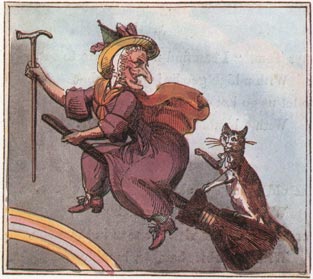
THE
FLIGHT
of
The Old Woman
who was
TOSSED UP IN A BASKET
Sketched & Etched
by
ALIQUIS
Cover
Text
Large panorama
Back cover
NOTE: I have scanned the book from a reprint published by Optical Toys in 1999. The book, along with many other paper wonders, is available for order from their site. Or you can contact Andy directly.
|
There was an old woman tossed up in a basket 'Old woman! old woman!! old woman!!!' quoth I. |
The seven feet vertical "unfolding panorama" was published by D. Bogue , 86 Fleet Street, London, in 1844, and attributed to Aliquis. Perhaps it provided the inspiration for George Cruikshank's 1849 horizontal panorama, The Toothache ![]() . It is the only book I know of that is to be read from the bottom up; so, if you choose to examine the large panorama, please be patient and wait until all the images are loaded.
. It is the only book I know of that is to be read from the bottom up; so, if you choose to examine the large panorama, please be patient and wait until all the images are loaded.
The history of the Old Woman with a broom tossed up into the sky is as old as that of recorded nursery rhymes: it appears, with no particular reason except for the editor's evident pleasure, in the preface to the earliest antology, Mother Goose's Melody; or Sonnets for the Cradle (compiled about 1765, published 1780, first surviving edition Isaiah Thomas, 1786, facsimile of a later edition with no Preface ![]() ), with an elaborate mock interpretation connecting it to Henry V's French campaigns. The tune it was sung to, "Lilliburlero"
), with an elaborate mock interpretation connecting it to Henry V's French campaigns. The tune it was sung to, "Lilliburlero" ![]() (for the score and music
(for the score and music ![]() you will need the free Scorch plugin, or just listen to the tune
you will need the free Scorch plugin, or just listen to the tune ![]() ), accounts for its association with a second king, since the famous melody "danced James II out of three kingdoms."
), accounts for its association with a second king, since the famous melody "danced James II out of three kingdoms."
When first observed, the Old Woman was being tossed up in a blanket (and our conscientious artist provides this too), seventeen times as high as the moon (and then variously ten, fifty, seventy and ninety-nine); earth's lonely satellite was not her destination, which is understandable as it must have been a very boring place , already occupied by a perfectly shakespearian Man in the Moon ![]() . Only her mission is clearly stated, she is is going "to sweep the cobwebs off the sky", and that it needed some cleaning is obvious from Betty Bundle's behaviour in another early nursery rhyme (Anon., Original Ditties for the Nursery , 1805, 1807 3
. Only her mission is clearly stated, she is is going "to sweep the cobwebs off the sky", and that it needed some cleaning is obvious from Betty Bundle's behaviour in another early nursery rhyme (Anon., Original Ditties for the Nursery , 1805, 1807 3 ![]() , pp. 17-8):
, pp. 17-8):
I. The sun, and Moon, and Stars, came down II. Then Betty Bundle at them threw |
(Betty's Grannam must have been a very different, more traditional type of woman with a broom .)
Much to our relief, the Old Woman's prompt action has the desired effect (Ibid., pp. 27-8):
I.
High diddledy doon, II. High diddledy doon, |
I. Pray tell me how the man in the moon II. Oh! though his pastimes are but scarce, |
The Man in the Moon appearing in our story, while not practising the activities here described, does not seem to be interested in the Old Woman's company. [back]

THE OLD WOMAN AND HER CAT There was an old woman, who rode on a broom, They travelled along till they came to the sky, Says Tom, 'I can find nothing here to eat, The old woman would not go back so soon, Says Tom, 'I'll go back by myself to our house, 'But,' says the old woman, 'how will you go? 'No, no,' says old Tom, 'I've a plan of my own, So now if you happen to visit the sky, |
Although this old woman may appear more adventurous in willingly starting such a perilous journey, her aim is clearly more limited: she just wants to visit that old bore, the Man in the Moon, perhaps to ask for a favour, or to help him kill his time.
Dame Dearlove's Ditties for the Nursery, London, John Harris and Son, 1819 ; from Iona and Peter Opie, eds., A Nursery Companion, Oxford, Oxford University Press, 1980, pp. 64-5. [back]